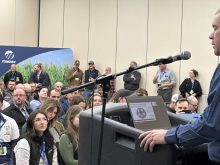Farmers who want to move into precision farming should focus less on satellite imagery and more on what’s happening under the soil’s surface, according to an agronomist.
Bennie Dunhin is the agronomy manager at Cavalier Agrow, an ag retailer based in north-western Saskatchewan. Dunhin, who originally hails from South Africa, holds an MSc. in plant pathology and is “obsessed” with plant nutrition.
He’s also a fan of precision farming, but said farmers have a long list of complaints with satellite imagery. Part of the answer, he told farmers during a farm forum in Glaslyn, Sask, is grid soil sampling.
Read Also

Cancer agency reclassifies another herbicide ‘probably carcinogenic’
The WHO’s cancer research agency has now put atrazine, a herbicide well known to corn growers, in the same potential-hazard category where the agency put glyphosate.
“I’m surprised that not a lot of people are looking into soil samples. I think everybody thinks that soil samples are labour intensive, cost too much,” said Dunhin during a coffee break interview. But by sampling the soil, agronomists can better predict what will happen in that spot, he added.
Cavalier Agrow has finished two years of intensive soil sampling as part of a precision ag program they’ve dubbed iFARM. When a farmer brings a new field into the program, Dunhin and his team sample five acre blocks using a customized soil-sampling truck.
In years two through four, they sample 40-acre blocks to check nitrogen levels, he said. They’ll resample five-acre blocks in the fifth year. Soil sample data is used to create maps and nutrient prescriptions.
Soil sampling is the most expensive part of the program, Dunhin said. But they get a break on lab fees, he added.
“If we had to pay normal lab fees, there’s no way that we could do this program. No way. Nobody can pay that.”
Since unrolling the program in 2014, Cavalier Agrow has sampled about 120 fields belong to 42 farmers. “We’ve punched over 47,000 holes in the ground.”
Fields are located everywhere from Meadow Lake to Unity, and as far east as Spiritwood and Medstead. Dunhin said they never enrol all of a farmer’s land in the first year.
“They need to see the differences and the value of the program.”
The deficiencies
Dunhin told farmers it’s too early in the program to see any differences in nutrients such as potassium and phosphate. But they’ve seen some trends in sampled soils. For example, well over 90 per cent of the sampled soils were deficient in copper and boron.
“It’s unreal the deficiencies we had. When I show this slide to industry people that don’t live in this part of the world, they cannot believe that we have that kind of deficiency in our soils,” Dunhin told farmers.
Nearly half of sampled soils had zinc deficiencies. Just over half had pH levels lower than six. About 40 per cent had potassium deficiencies. Dunhin also noted some soils had salt issues, magnesium deficiencies, or organic matter topping 10 per cent.
Typically zinc levels can vary through the field, Dunhin said. But he noted fields with a history of hog manure application don’t have any zinc deficiencies. Farmers need to be aware of how and where to apply hog manure, he cautioned.
“But if you have zinc problems, hog manure is a pretty good thing to do.”
Nutrient deficiencies favour certain weeds, Dunhin told farmers. For example, sow thistle prefers soils with low calcium, low potassium, high magnesium, high moisture, and low microbial activity. Soil maps can tell farmers where to scout for certain weeds. Dunhin also hopes to train agronomists to make nutrient recommendations to help manage weeds.
“If we can more effectively control weeds just by changing the nutrition on the field, that’s a win-win for every-body.”
Dunhin also showed farmers how yield maps can be correlated with soil sampling maps. For example, if high iron levels are correlated to lower yields in a specific field, that probably means iron levels are too high in the field.
If there’s a strong correlation between higher calcium levels and higher yield, this points to calcium-deficient soils, he said. Dunhin cautioned these examples are field-specific and don’t apply to all soils.
Dunhin hopes to add correlation services to the iFARM platform.
When it comes to precision farming, variable rate prescription maps and a nutrition plan aren’t enough, said Dunhin. In the near future, Cavalier Agrow also plans to offer everything from variable rate seeding maps to yield map analysis to farm business planning services, he said.
“This is intelligent farming. And this is how we need to think about the future and go forward with what we want to do on the farm.”














